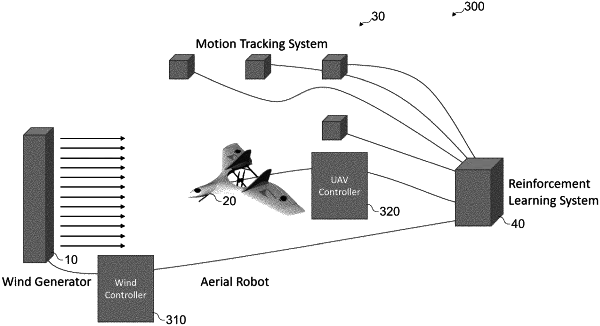| CPC G08G 5/0069 (2013.01) [B64C 39/024 (2013.01); F03D 7/00 (2013.01); F03D 7/0276 (2013.01); F03D 7/04 (2013.01); G06N 20/20 (2019.01); G06T 7/20 (2013.01); G06T 7/70 (2017.01); G06T 7/75 (2017.01); G08G 5/0013 (2013.01); B64U 2201/10 (2023.01); F03D 7/045 (2013.01); F03D 7/046 (2013.01)] | 15 Claims |

|
1. A method for designing an Unmanned Aerial Vehicle (UAV) controller model for controlling an UAV, the method comprising:
Generating a wind generator control signal based on a wind controller model, wherein a wind current emitted towards the UAV is based on the wind controller model;
Providing the wind generator control signal to the wind generator, to cause the wind generator to emit the wind current;
Operating the UAV using the UAV controller model, wherein a flight of the UAV is influenced by the wind generated by the wind generator;
Monitoring the flight of the UAV using a motion-tracking system to determine motion-tracking data;
Controlling the wind generator control signal to increase a difference between a desired flight path of the UAV and a flight path of the UAV as monitored by the motion-tracking system;
Synthesizing the wind controller model using a machine-learning algorithm based on the motion-tracking data, wherein the machine-learning algorithm is an adversarial reinforcement learning-based machine-learning algorithm or a population-based machine-learning algorithm; and
Synthesizing the UAV controller model using the machine-learning algorithm based on the motion-tracking data, wherein the UAV controller model and the wind controller model are trained against each other using an adversarial reinforcement learning-based machine-learning algorithm or a population-based machine-learning algorithm in which the UAV controller model is synthesized to minimize the difference between the desired flight path of the UAV and the flight path of the UAV and the wind controller model is synthesized to maximize the difference between the desired flight path of the UAV and the flight path of the UAV.
|